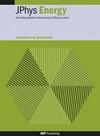Critical review on the controllable growth and post-annealing on the heterojunction of the kesterite solar cells
IF 6.3
3区 材料科学
Q1 ENERGY & FUELS
引用次数: 0
Abstract
Kesterite-structured solar cells have drawn significant attention due to their low-cost and environmental friendly composition. Recently, a remarkable certified power conversion efficiency (PCE) of 14.9% has been achieved, indicating a broader prospect for kesterite solar cells. However, this PCE is still far below the theoretical efficiency and the PCE of predecessor Cu(In,Ga)Se2 solar cells, which have been commercialized successfully. The relatively low device efficiency primarily originates from the unfavorable bulk and heterojunction of kesterite solar cell. Therefore, the achievement of high PCE in kesterite solar cells heavily relies on high-quality absorber layers and appropriate heterojunction contact. In this review, we first summarize the recent studies on the controllable growth of kesterite thin film. Based on different fabrication methods, various endeavors in revealing the reaction mechanism and manipulating the growth pathway of kesterite thin films have been introduced. Subsequently, studies related to the optimization of heterojunction by post-annealing process are also summarized. This simple and convenient approach can effectively enhance the heterojunction contact and promote the carrier transportation. Finally, this article discusses the future development strategy and perspectives towards achieving enhanced PCE in kesterite thin film solar cells.关于可控生长和异质结退火的重要综述
钾长石结构太阳能电池因其低成本和环保成分而备受关注。最近,经认证的功率转换效率(PCE)达到了令人瞩目的 14.9%,这预示着钾长石太阳能电池具有更广阔的前景。然而,这一 PCE 仍远低于已成功商业化的前代 Cu(In,Ga)Se2 太阳能电池的理论效率和 PCE。器件效率相对较低的主要原因是凯斯特太阳能电池的块体和异质结不理想。因此,要在钾长石太阳能电池中实现较高的 PCE,在很大程度上依赖于高质量的吸收层和适当的异质结接触。在这篇综述中,我们首先总结了近期有关可控生长钾长石薄膜的研究。根据不同的制备方法,介绍了揭示反应机理和操纵克斯特石薄膜生长途径的各种努力。随后,还总结了通过后退火工艺优化异质结的相关研究。这种简单方便的方法能有效增强异质结接触并促进载流子传输。最后,本文还讨论了实现提高开斯特石薄膜太阳能电池 PCE 的未来发展战略和前景。
本文章由计算机程序翻译,如有差异,请以英文原文为准。
求助全文
约1分钟内获得全文
求助全文
来源期刊

Journal of Physics-Energy
Multiple-
CiteScore
10.90
自引率
1.40%
发文量
58
期刊介绍:
The Journal of Physics-Energy is an interdisciplinary and fully open-access publication dedicated to setting the agenda for the identification and dissemination of the most exciting and significant advancements in all realms of energy-related research. Committed to the principles of open science, JPhys Energy is designed to maximize the exchange of knowledge between both established and emerging communities, thereby fostering a collaborative and inclusive environment for the advancement of energy research.
 求助内容:
求助内容: 应助结果提醒方式:
应助结果提醒方式:


